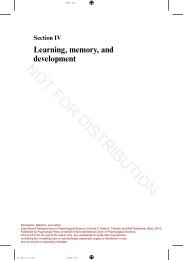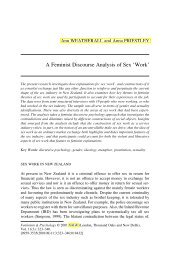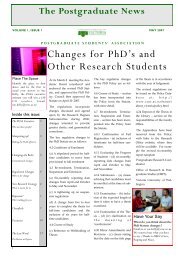green & myerson 2004.. - of /courses
green & myerson 2004.. - of /courses
green & myerson 2004.. - of /courses
Create successful ePaper yourself
Turn your PDF publications into a flip-book with our unique Google optimized e-Paper software.
Green and Myerson Page 16 <strong>of</strong> 48<br />
NIH-PA Author Manuscript NIH-PA Author Manuscript NIH-PA Author Manuscript<br />
seen in the left graph in Figure 12, which depicts data from the $200 and $5,000 probabilistic<br />
reward conditions <strong>of</strong> Experiment 2 <strong>of</strong> Green et al. (1999a). In contrast, the right graph depicts<br />
the data from the corresponding delayed reward conditions <strong>of</strong> this experiment in which, as may<br />
be seen, the smaller reward was discounted more steeply than the larger reward. Green et al.<br />
(1999a) also examined discounting <strong>of</strong> three other hypothetical reward amounts and showed<br />
that as amount increased from $200 to $100,000, probabilistic rewards were discounted more<br />
and more steeply, whereas for delayed rewards, the degree <strong>of</strong> discounting decreased from $200<br />
to $10,000, with little systematic change when amount was increased further.<br />
Results consistent with those <strong>of</strong> Green et al. (1999a) have been obtained by Christensen et al.<br />
(1998) using a very different procedure. Both studies involved choices between a smaller,<br />
certain reward and a larger, probabilistic reward and also between a smaller, immediate reward<br />
and a larger, delayed reward. However, Christensen et al. adjusted the probability <strong>of</strong> the larger<br />
reward on the basis <strong>of</strong> a participant’s choice on the previous trial in the probability discounting<br />
conditions, whereas Green et al. (1999a) adjusted the amount <strong>of</strong> the smaller, certain reward.<br />
In addition, Christensen et al. adjusted the delay to the larger reward on the basis <strong>of</strong> a<br />
participant’s choice on the previous trial in the temporal discounting conditions, whereas Green<br />
et al. (1999a) adjusted the amount <strong>of</strong> the smaller, immediate reward. Despite these procedural<br />
differences, both studies show consistent results in terms <strong>of</strong> the opposite effects <strong>of</strong> amount on<br />
temporal and probability discounting rates. Christensen et al. also reported that the pattern <strong>of</strong><br />
results observed when participants had the possibility <strong>of</strong> receiving real monetary rewards was<br />
similar to that when participants made choices involving purely hypothetical rewards.<br />
A recent study (Myerson et al., 2003) examined whether amount <strong>of</strong> hypothetical reward has<br />
different effects on the exponents <strong>of</strong> the temporal and probability discounting functions<br />
(Equations 3 and 5, respectively). Amount <strong>of</strong> reward had no significant effect on the exponent<br />
<strong>of</strong> the temporal discounting function in either <strong>of</strong> two relatively large samples (both Ns > 100).<br />
In contrast, the exponent <strong>of</strong> the probability discounting function increased significantly with<br />
the amount <strong>of</strong> reward in both samples. Moreover, subsequent analyses revealed that although<br />
the temporal discounting rate parameter, k, decreased significantly with amount <strong>of</strong> reward,<br />
there was no significant change in h, the probability discounting rate parameter. Thus, despite<br />
the similarity in the mathematical form <strong>of</strong> the temporal and probability discounting functions,<br />
the finding that amount <strong>of</strong> reward differentially affects the parameters <strong>of</strong> these functions<br />
suggests that separate processes may underlie the discounting <strong>of</strong> delayed and probabilistic<br />
rewards.<br />
The opposite effects <strong>of</strong> amount on temporal and probability discounting pose problems for<br />
approaches that decompose the discounting function into value and weighting functions and<br />
then localize, either explicitly or implicitly, the effect <strong>of</strong> amount in the value function. Because<br />
the same value function applies in both temporal and probability discounting, such approaches<br />
must predict similar magnitude effects in both domains. For example, Prelec and Loewenstein’s<br />
(1991) model localizes the effect <strong>of</strong> amount in the value function, which enables them to<br />
correctly predict the magnitude effect in choices involving delayed rewards. As applied to<br />
reward amount, increasing proportional sensitivity predicts that multiplying the amounts<br />
involved by a constant will increase the weight given to the amount attribute. Consider the case<br />
in which an individual must choose between $10 now and $20 in a year and also between<br />
$10,000 now and $20,000 in a year. Increasing proportional sensitivity predicts that an<br />
individual who chooses the immediate $10 option in the first situation might well choose the<br />
delayed $20,000 option in the second situation. This is consistent with the finding that larger<br />
delayed amounts are discounted less steeply than smaller amounts.<br />
Psychol Bull. Author manuscript; available in PMC 2006 February 24.






